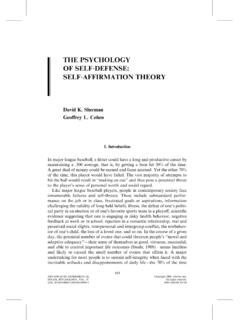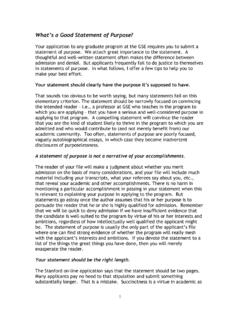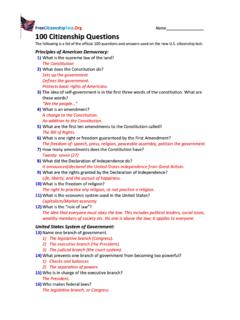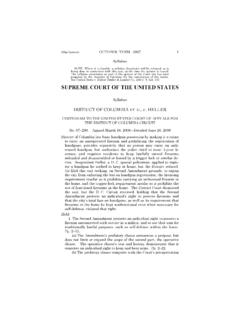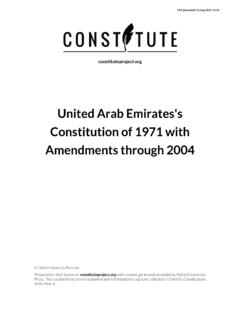Transcription of Inequality Matters - Stanford Graduate School of Education
1 Inequality Matters Prudence L. Carter and Sean F. Reardon Stanford University A William T. Grant Foundation Inequality Paper September, 2014. Direct correspondence to and An earlier version of this paper was prepared for the Ford Foundation's Building Knowledge for Social Justice Project. We thank Lauren Fox, Joe Luesse, Anna Comerford, and Ericka Weathers for their very helpful research assistance on this project; Amy Stuart Wells and Jeanne Oakes for their support and facilitation of the initial project that launched this paper; and the members of the Ford Foundation Transformative Research Working Group David Berliner, Evelyn Brooks Higgenbotham, Patricia Gandara, Kris Gutierrez, Linda Darling-Hammond, Mark Sawyer, Valerie Smith, and Hiro Yoshikawa for their critical insights and views on the state of Inequality research.
2 Overview Talk of Inequality , particularly economic Inequality , discipline including sociology, economics, political in the public sphere is commonplace in twenty-first science, psychology, anthropology, history, philosophy, century America. Indeed, various aspects of social epidemiology, public health, Education , and public policy . Inequality race, gender, class, sexual orientation, and includes a rich body of work addressing the definitions, immigrant status have been the subject of protest, patterns, causes, and consequences of social Inequality . debate, legislation, and judicial action for much of the Given this extensive scholarly attention, one would think last century. Inequality in its various forms and what that we know a great deal about social Inequality and to do about it, if anything is often the animating force maybe something about how to reduce it.
3 While we have behind much of contemporary political debates and social increased our knowledge about Inequality , there are some movements. These debates take place against a backdrop aspects of Inequality about which we have insufficient of fitful progress and retreat in America's long struggle knowledge. We have produced considerably less research with Inequality . to inform policy and practice about interventions to reduce it. Although we have made some significant progress on racial equality in the last 60 years in Education , Our aim in this paper is to describe, in very broad health, legal rights, and housing access much of that brushstrokes, the state of academic scholarship regarding advancement stalled in the 1970s and 1980s, leaving us social Inequality , with an eye toward identifying far from racial equality in any particular domain that important gaps.
4 We focus on four key interacting social influences life chances. Economic Inequality in the domains: (1) socioeconomic (financial and human capital), United States, meanwhile, has been growing steadily (2) health (including physical and psychological), (3). for nearly 40 years, challenging the idea that America is political (access to power and political representation), a land of economic opportunity. Traditional patterns of and (4) sociocultural (identity, cultural freedoms, and gender Inequality have been eliminated or even reversed human rights). Our reading of the research reveals in some aspects of Education and health, but remain that the evidence regarding Inequality , its causes, and stubbornly persistent in the segmented labor market, consequences is mixed.
5 In many cases, divergent findings wage structures, and politics, for example. The lesbian, can be attributed to conceptual and methodological gay, bisexual, and transgender (LGBT) communities have differences among studies. In other cases, there is simply attained some semblances of equal protection in some not enough high-quality research, often due a lack of spheres, but they still face enormous bias and invisibility relevant data, to form firm, evidence-based conclusions. in many others. In short, we still have a long way to go on the questions and practices of social equality. We identify four notable gaps in the scholarship on social Inequality . First, we know far too little about Inequality The causes and consequences of these trends in of opportunity, relative to what we know about Inequality social Inequality in the United States have been the of outcomes.
6 More focused attention, we argue, should subject of a large body of scholarship. Every academic be given to unpacking the ecology of economic, political, William T. Grant Foundation 2014 Inequality Matters 1. social, and cultural influences that shape individuals'. and communities' life chances and welfare. Evidence of unequal outcomes is insufficient for a full understanding of the processes that produce these inequalities. Second, the scholarship of the last few decades has been much more successful at documenting the patterns, trends, and (to some extent) causes of social Inequality than it has been at demonstrating its consequences or identifying effective strategies for reducing it. Research on strategies for reducing Inequality has largely focused on evaluating policies and interventions designed to improve life chances for those at the bottom end of the Inequality distribution.
7 Much less research has addressed broader strategies for reducing Inequality . Third, scholarship on the causes and persistence of Inequality has focused too little on Inequality -preserving social processes that are difficult to observe such as the roles of elites, private institutions, and corporations in shaping the policies that produce and reinforce Inequality or social and historical reproduction processes that create and maintain common sense . notions of the sources of Inequality . For example, some popular narratives frame the black-white academic achievement gap and racial and economic Inequality as natural facts that result from inherent group differences, rather than viewing them as socially constructed patterns produced by generations of unequal opportunities.
8 Fourth and finally, the problem of Inequality has been framed in both scholarship and in public discourse as a problem of poverty (or some other form of social disadvantage). In other words, scholarship often asks why are the poor poor? and what are the consequences of poverty? rather than why are socioeconomic conditions, health outcomes, and the distribution of political power so unequal? or what are the consequences of Inequality for society? This framework narrows the scope of research, and thereby limits our understanding of the issue. William T. Grant Foundation 2014 Inequality Matters 2. What Do We Mean By Inequality ? In discussing social inequalities, it is important to to power, resources, and life chances. Between-group make two distinctions.
9 First is the difference between Inequality includes racial or gender income differences, the unequal distribution of desirable life outcomes immigrant group differences in access to political power, (such as health, happiness, educational success, or religious group differences in social or political rights, and material possessions) and the unequal distribution of socioeconomic differences in access to quality Education opportunities (access to power and life chances that and health care. facilitate attainment of desirable outcomes). Second is the distinction between the unequal distribution of Given evidence of the unequal distribution of life opportunities and outcomes among individuals and chances, power, and resources, scholarship should be between groups.
10 The idea of equality of outcomes versus able to explain the extent to which Inequality arises from equality of opportunities appears straightforward, but differing access to opportunity or other factors (such as can be complicated to pin down in practice. In part this luck or variation in choices that individuals make even is because opportunity is an inherently slippery notion, in the presence of equal opportunity and information). making it very difficult to precisely measure equality Moreover, it should be able to identify whether the key of opportunity. Opportunity can also be a feature of an processes at play are group- or individual-level processes. interaction between an individual and his or her context, a In the case of between-group Inequality of outcomes, point Jencks (1988) makes in his illuminating discussion scholarship should examine the sources of this Inequality .


